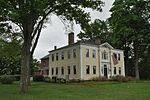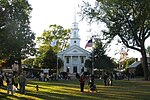WLCQ-LP
Christian radio stations in MassachusettsContemporary Christian radio stations in the United StatesLow-power FM radio stations in MassachusettsMass media in Hampden County, MassachusettsMassachusetts radio station stubs ... and 1 more
Radio stations established in 2006

WLCQ-LP (99.7 FM, "The Q 99.7") is a radio station licensed to serve Feeding Hills, Massachusetts. The station is owned by Lighthouse Christian Center. It airs a Christian Contemporary music format.The station was assigned the WLCQ-LP call letters by the Federal Communications Commission on June 18, 2005.
Excerpt from the Wikipedia article WLCQ-LP (License: CC BY-SA 3.0, Authors, Images).WLCQ-LP
McKinley Street,
Geographical coordinates (GPS) Address Nearby Places Show on map
Geographical coordinates (GPS)
| Latitude | Longitude |
|---|---|
| N 42.083055555556 ° | E -72.646388888889 ° |
Address
McKinley Street 17
01001
Massachusetts, United States
Open on Google Maps









